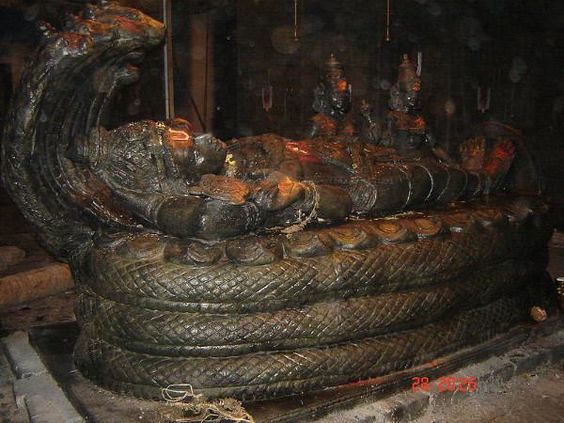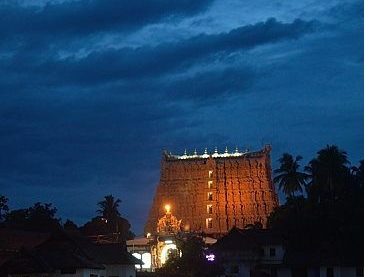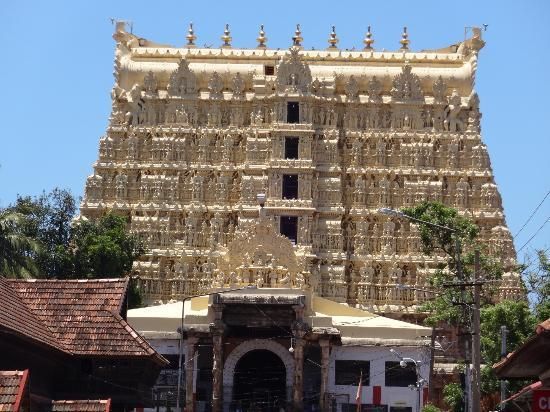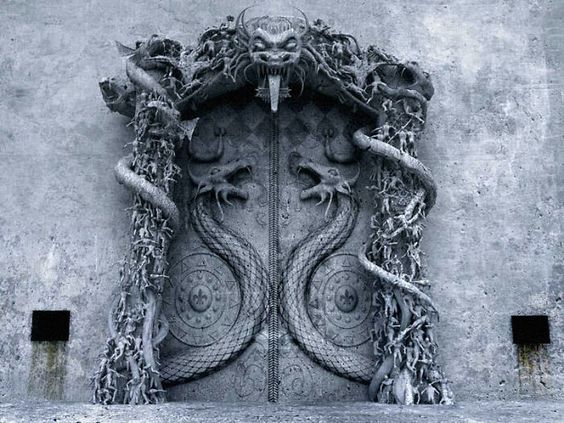This article is going to be the most detailed analysis of the Padmanabhaswamy temple , including its history , its renovation, deities , mysteries, expeditions, verdicts by Kerala high court and the final verdict by the supreme court.
Contents
- About the temple
- Temple Structure and Deities
- Royal family of Travancore
- History of the temple
- Temple under Travancore Kingdom
- Temple under British Rule
- Accession by Indian Government
- Dispute over temple administration
- Legal Challenge to Royal family
- High and supreme court verdicts
- Mysterious Gates and treasure
- Mystery of Vault B
Padmanabhaswamy Temple
Shree Padmanabhswamy temple is a grand temple dedicated to Lord Vishnu ,located in Tiruvananthpuram ,Kerala . The main deity of Vishnu is in the ” Anantha Shayana ” position – in the eternal yogic sleep, reclining on the thousand headed Adishesha. The temple is one of the wealthiest temple in the world. Due to this reason it is also called ” The golden temple”. There are many legends behind the construction of the temple , but the last mahor renovation of the temple was done by Anizham Thirunal Marthanda Varma, the ruler of kingdom of Travancore in 1731.
Only the people of Hindu faith or religion are allowed to enter the temple . The temple follows strict dress code . It is mandatory for men to wear Dhoti and women to wear Saree while entering the temple.
Besides being of religious and spiritual importance , the temple is also linked to various mysteries , which we will cover later in this article.
Temple Structure and Deities

The temple is constructed in the Chera style of architecture having high walls and the Gopura ( of height 100 ft or 30m) is in the Pandayan style.
Main Deities
- Padmanabha(Vishnu) resting on Adishesha
- Shiva Lingam
- Sri-Devi Lakshmi, consort of Vishnu
- Bhudevi, the goddess of earth
- Devtas – Garuda, Narada, Surya ,Tumbru, Surya , Chandra, Saptarishi
The main deity of Padmanabhaswamy is made of Shaligram , from Gandaki river in Nepal, north of Varanasi. These were collected by the king Marthandvarman , before the construction of the temple.
Other deities
The other deities were carried to south India to the kingdom of Travancore by the Vrishni Kshatriyas ( people of lineage of Lord Krishna) to present to the king, and the king installed the deities in the temple independently, each having their own sanctorum and rituals.
These deities include – Krishna , Narsimha , Rama, Sita, Lakshmana, Hanuman , Ganpati , VedaVyasa, Vishwaksena ,Garuda etc.
Royal family of Travancore
The royal family of Travancore ruled the kingdom of Travancore as early as 800 CE . They were the descendants of Cheras, Cholas and Pandyas. In the first half of eighteenth century the kingdom was succeeded by Anizham Thirunal Marthanda Varma at the age of 23. He was a very powerful ruler , who successfully managed to supress the nobles and once again monarchy into power in Travancore.
Padmanabhaswamy is the guardian deity of the royal family of Travancore .In 1750 , Marthanda Varma surrendered the entire kingdom of Travancore to Padmanabhaswamy and declared that he and his descendants would be the servants of the deity and serve the kingdom as the servants ( dasa) of the deity known as ‘Padmanabha Dasa’ .
The rulers gave up their monarchial rights in 1949 after the kingdom of Travancore merged with India after independence. Padmanabhaswamy is still the patron deity of the royal family and the members of this family has the title of ‘Padmanabha Das’ which they gain after performing a religious ceremony after the child’s birth .
History of the Temple

The temple is mentioned in various Hindu texts like Brahma Purana, Vishnu Purana, Matsya purana and all major Vaishnava texts. It is also referred in the Sangam literature (earliest known literature of South India) of around 500 BC to 300 AD .Different legends are linked to the origin of the temple in different texts and among the common folklores of the people.
One of the most popular legends says that Parshuram ( who is the founder of the state of Kerala and a avatar of Vishnu), venerated the idol of Vishnu ( Sree Padmanabhaswamy), in Dwapara Yuga in order to get rid of the sin of killing Kshatriyas. Since there are different stories in different religious books, it is not very clear as to when the temple was originally established.
Temple under Travancore Kingdom
The temple became a central religious centre only under the administration of the Travancore kingdom ,when Anizham Thirunal Marthandavarman took over the reins of the temple in early eighteenth century.
During those times , the monarchial order was destroyed and the administration was led by Ettuveetil Pillamar, meaning lord of eight houses. This was a group of nine people , with eight and half powers. Seven of them were Brahmins , having one power (vote) each , one was the the Nair cheiftain having one vote and the last one was the king having half vote , making him of negligible power.
These eight and half powers faced strong opposing when Marthandvarman successes the throne, and this resulted in a bloody conquest between Marthandvarman and the priestly nobles in 1720s. Marthandvarman succeeded in the battle and took control of the kingdom restoring the order of monarchy .
The conquest was on a grand scale , and just like Ashoka changed after the infamous war of Kalinga, so did Marthandvarman and decided to surrender his entire kingdom to the deity of Padmanabhaswamy and declared himself as slave of the temple . Since then the deity is the protector or guardian of the royal family .
Temple Under British Rule

After the death of Marthandvarman in 1758, at the age of 53, the British entered the administration of the temple. The temples were so rich that the kingdom took loans from it to run the administration.
In 1811 , all major Hindu temples in Travancore were made under the control of the king and this arrangement continued until the merging of kingdom in Independent India in 1949.
Accession of Temple by Indian Government
In 1949 , an instrument of accession was signed with the Indian Union , which integrated the princely states of Travancore and Cochin into one as a territory of India.
Article VIII of the covenant guarantees the ruler of the kingdom (Shri Chithira Thirunal Balarama Varma) the right to maintain and administer the temple , along with a committee of three members made by the ruler himself. In 1965, a trust ( committee ) of four members named ‘ Padmanabhaswamy Trust ‘ was established by the then ruler of Travancore state to manage the expenses of the daily rituals, festivals and pooja at the temple.
The issue of accession was solved at this stage.
Dispute over the Temple Administration (1991)
In 1991, Chithira Thirunal Balarama Varman died. His death gave birth to a dispute that whether the position of ‘ruler’ as mentioned in the eight article of covenant should end with him in 1991 or continued with his descendants.
Legal Challenge to the Royal family
In 2007, on behalf of two devotees a case was filed against the temple administration for mismanaging the temple and pleaded that the government appoint new trustees to manage the deity’s wealth.
Trivendrum lower court ordered the government to take over the management of the temple . However , this was opposed by the royal family for the reason that for centuries they have protected the temple and its deity .
Verdicts by the courts

1.Kerala High Court – In 2011 , the Kerala highcourt passed a judgement that denied the royal family the right of management of the temple saying that the title of ruler itself gets abolished after the death of Balarama Varman and his successors lost the claim to the management of the temple as well.
Soon after the verdict the court gave the order to state governments to form a committee to take over the rights of the temple and open the vaults to check for the treasures.
Being dissatisfied by the judgement of high court the family moved to supreme court .
2.Supreme court – The Supreme court overturned the decision of high court and acknowledged the special relationship of the royal family as ” Sebait” (servant of the deity) in aritcle VIII.
Hence, the family continued to enjoy the right not because of its being a ‘royal family’ but because of its lineage of having been the custodian for centuries.
The Mysterious Gates of Padmanabhaswamy Temple
A seven member experts team was appointed by the supreme court to open the vaults( gates ) of the temple with the agreement of the ruler. These vaults were named as A,B,C,D,E,F. In april 2014, two more vaults were found named as G and H.
Except the vault B , all vaults were opened by the government and the expert team found solid gold statues, gold sheets weighing hundreds of kilos, over 60,000 diamonds and gems and Roman gold coins ( each costing 2.7 crores) in thousands. There are multiple gold crowns, golden idols of various deities, an eighteen feet long pure gold chain and several sacks filled with golden artefacts, necklaces, diadems, diamonds, rubies, sapphires, emeralds, gemstones, and objects made of other precious metals.
Altogether the articles found in A to F ( except B) , would cost more than 1 lakh crore or much more than this .
The treasure made this temple as the richest temple in the world, thus drawing global attention to the history of the temple and giving it an international significance.
On 13 July , the order of High court was completely overturned by the supreme court saying that the legal authority and right of management of the temple would rest with the royal family of Travancore.
Mystery of Vault B

The team of seven members postponed the opening of vault B on account of the popular tales of the chamber being cursed , the same is also affirmed by the royal family . It is said that during the time of Marthandavarman ( 1750s), a ruler tried to loot the wealth of the temple by deceit .He sent his soldiers to the open vault B and they were chased to death by millions of snakes. This was considered as a divine intervention by the locals and since then no one dared to open the vault. It is also said that the vault is protected with religious sacred Mantras and can be opened by learnt scholars and saints.
To know the will of the deity , a religious ritual called ‘Ashtamangal Devaprasanam’ was conducted the priest and it was concluded that breaking the door would be a bad omen and a work of displeasing the deity leading to worldly catastrophe and imbalance.
One of the oldest estimates on the treasure in vault B was made by Royal family in 1880s, which says that there is gold worth about 10,000 crores ( compared to rate of gold in 1880), which would cost more than US dollar 1 Trillion in todays world.
For now , the opening of vault B , is strongly criticized by the temple authorities and the priest of the temple and it is not going to be opened in the nearby future thus maintaining the mystery of the unclarified treasures of the unopened chambers.